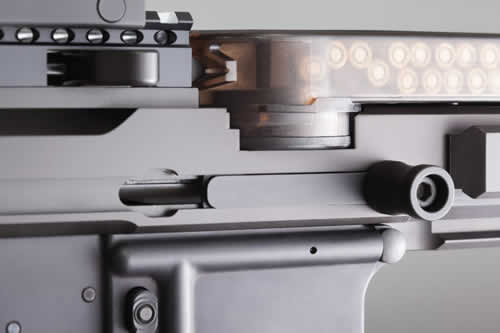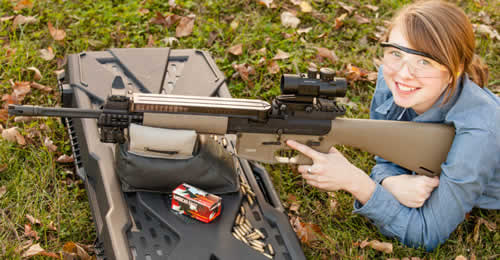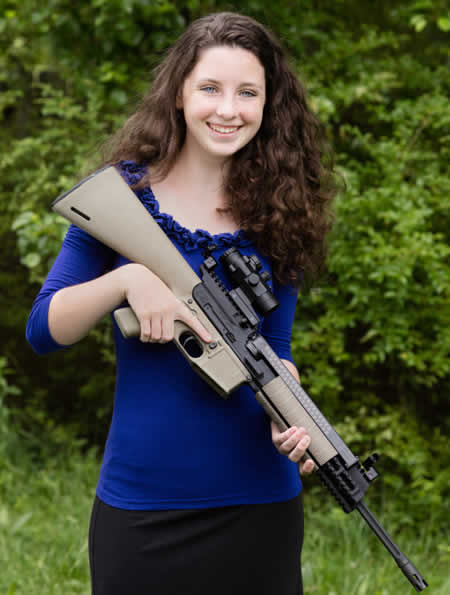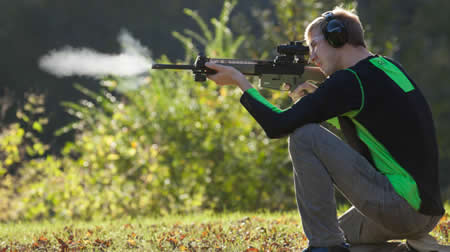STORY AND PHOTOGRAPHS BY OLEG VOLKThe AR57 (also known as the AR Five Seven) upper receiver for the AR-15 has two claims to fame: a 50-shot capacity and downward ejection for ambidextrous operation. Operating by simple blowback, this upper is available in 6-inch pistol and 16-inch rifle versions, with the latter being reviewed here.
Thank you for reading this post, don't forget to follow and signup for notifications!

Manufactured by the eponymous AR57 LLC, and chambered in 5.7x28mm, this upper is less powerful than the standard 5.56mm version, but it has certain tangible advantages, including reduced muzzle blast, a high practical rate of fire, nonexistent recoil, and the ability to use folding stocks. Since the buffer is located within the receiver, folding stocks may also be used for compact storage or carry.
To load, place the base plate of a standard FN P90 magazine into the recess on the front of the upper, then press the feed lip side down on the catch located above and slightly back of the bolt. To charge, pull on the right-side nonreciprocating handle and release. The right-side charging hand placement makes it accessible for operation by the strong hand. Since it only has to be operated once every 50 shots, the time penalty for moving the hand off the pistol grip isn’t too great.
Empties will eject downward through the nominal magazine well. Some people use a 20-round magazine body with the feed lips, spring and follower removed to act as a brass catcher.
The magazine has no provision for activating the bolt lock when empty, but the bolt can be locked open using the catch on the lower. The upper runs very cleanly and reliably, requiring no maintenance after the first 500 shots.
The AR57 comes with a medium fluted barrel, reasonable for a varmint rifle but excessive for a defensive carbine. Burning around six grains per shot, 5.7x28mm runs much cooler than 5.56mm, which burns four or more times as much. That yields much reduced muzzle blast and far greater heat endurance, of course at the cost of a roughly 40 percent slower bullet.
 The baseplate of a standard FN P90 magazine fits snugly into the
The baseplate of a standard FN P90 magazine fits snugly into the
recess on the front of the upper.
CHOOSING LOADSThe adequacy of 5.7x28mm for stopping human aggressors has been in dispute ever since its introduction. Some of the lighter bullets available for the caliber have traditionally been tipped or leadless hollow points prone to excessive fragmentation. Firing a 27-grain lead-free hollow point at a full, upright 12-ounce beverage can did not produce a complete penetration – an excellent result for a range or a small varmint round, but not a man-stopper.
 With no protruding magazine, the AR57 allows shooters to get very
With no protruding magazine, the AR57 allows shooters to get very
low into a prone position.
Expanding ammunition with better penetration is also available from FN, along with nonfragmenting 40-grain FMJ American Eagle. Recently, RR Weapon Systems introduced two 37-grain all-copper loads, 37F (fragmenting) and 37X (expanding). In testing 37X, I found it much hotter than the alternatives and a very reliable terminal performer. The three-petal bullets expanded to fill 2/3-inch circumference and penetrated around 12 inches into gel. Velocity was around 2,680 feet per second with a standard deviation of under 10, so it was no surprise that it produced groups a touch under 2 inches. Other than handloads with 40-grain Vmax, all other ammunition grouped closer to 2.5 to 3 minutes of angle when fired using a 2.5x scope.

 The AR57 is an excellent choice for self-defense, especially
The AR57 is an excellent choice for self-defense, especially
for individuals of smaller stature.
The main limitation on the use of an AR57 for varmint control is the space available for optics. Because the magazine is lifted up for unloading, the potential length of the scope is sharply limited. I have been able to fit 2.5x or 4x prismatic scopes, but anything longer caused interference. Considering these sighting limitations, I would rate it as suitable for small rodents out to 100 yards.
Accuracy is a less important consideration for defensive use. Follow-up shots with the AR57 are limited only by the trigger finger dexterity, as it showed no muzzle rise at all. Up close, this platform would be better served with a red dot sight and a laser for rapid aiming. I’d like to see a defensive variant with a pencil-thin barrel and a more skeletonized forend developed alongside the current version.
Compared to the PS90, the AR57 is the heavier option, even when polymer lowers are used. It is also longer. But the advantages of an AR57 are numerous. Even a stock AR-15 has a better trigger than a PS90, and aftermarket options can enhance that difference a great deal. AR lowers allow adjustable length of pull, and AR ergonomics make more use of existing training, other than in the reloading process. The height of sights over bore is significantly less, making accurate hits easier.
 This functional upper features several advantages, including reduced
This functional upper features several advantages, including reduced
muzzle blast, a high practical rate of fire, and nonexistent recoil.
Compared to a 5.56 upper, the AR57 is simpler to clean, generates less felt recoil and much less muzzle blast. With no protruding magazine, it allows the shooter to get very low into a prone position. Two full 50-round P90 magazines weigh as little as one 5.56 30-rounder, so you can carry a lot of ammunition.
At $745 direct from the manufacturer or an authorized dealer, it is less expensive than a PS90 carbine (which lists at $1350), even after the cost of an AR-15 lower is added in. The 5.7x28mm ammunition costs about the same as 5.56x45mm, though the variety of available loads is definitely smaller.
The niche I see for AR57 – besides it being plain fun to shoot – is for self-defense by the same slightly built individuals who would have picked an M1 carbine in the past. It requires less upper body strength to use than most long guns, and gives 50 shots without reloading. A small teenager or a fragile senior can run it with ease, but the rest of us won’t need an excuse to enjoy using this upper.
AmSJ



